Quality Assurance: Continuous Improvement in Food Production
VerifiedAdded on 2023/06/12
|9
|2012
|397
Report
AI Summary
This report provides a comprehensive analysis of quality assurance and continuous improvement within a business context, referencing Oakland’s Total Quality Management (TQM) model and ISO 9001:2015 standards. It discusses how continuous improvement is embedded in quality management frameworks and explores approaches like the PDCA cycle. The report also examines the roles of Hazard Analysis and Critical Control Points (HACCP) and regulatory environments in ensuring food safety. Furthermore, it delves into key quality attributes for new product development, such as ice cream, including physico-chemical components, melting resistance, and sensory analysis. The report also highlights the importance of risk management and control strategies by senior managers, and contrasts Lean mechanisms with the Six Sigma DMAIC framework, emphasizing the need for customer satisfaction and process optimization. Desklib provides access to similar solved assignments and past papers for students.
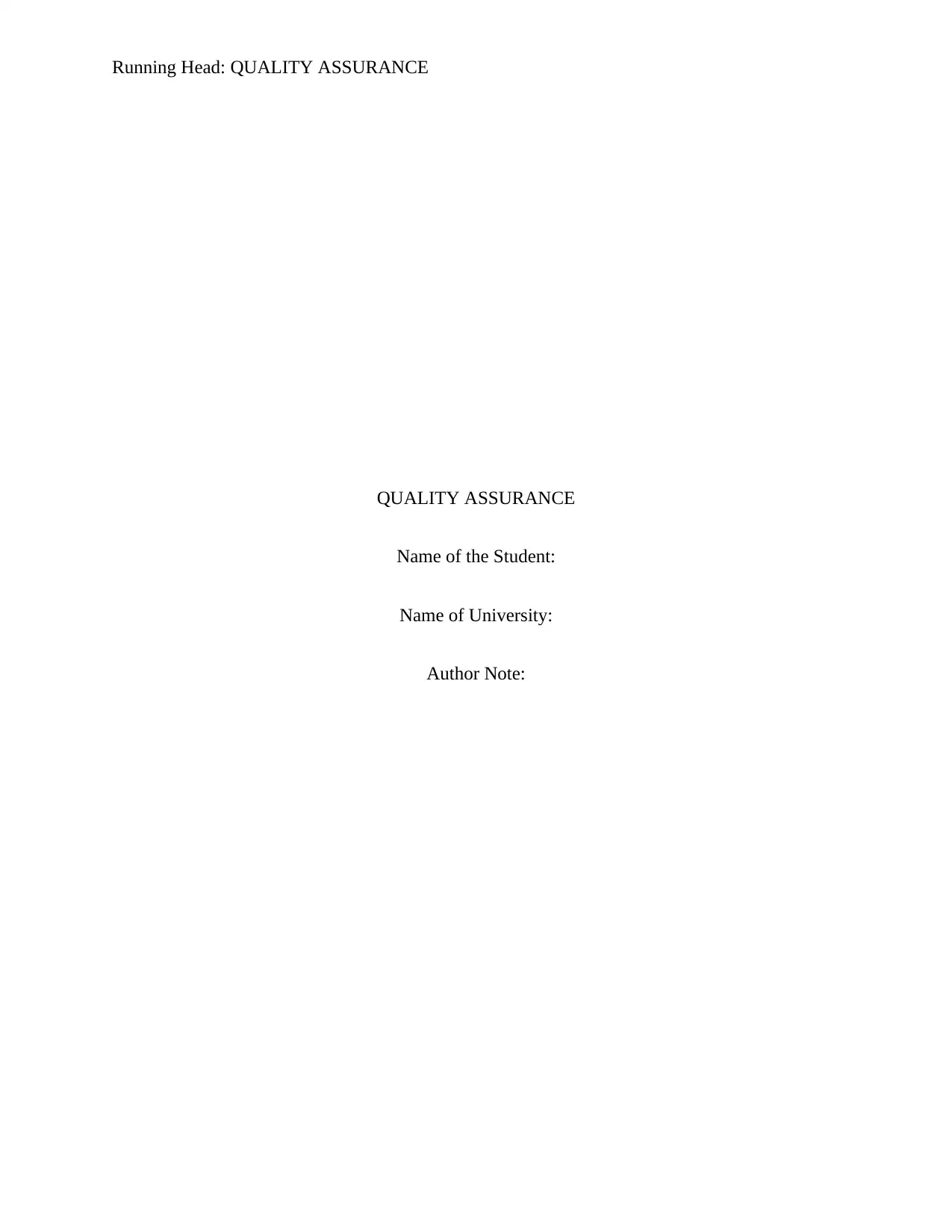
Running Head: QUALITY ASSURANCE
QUALITY ASSURANCE
Name of the Student:
Name of University:
Author Note:
QUALITY ASSURANCE
Name of the Student:
Name of University:
Author Note:
Paraphrase This Document
Need a fresh take? Get an instant paraphrase of this document with our AI Paraphraser
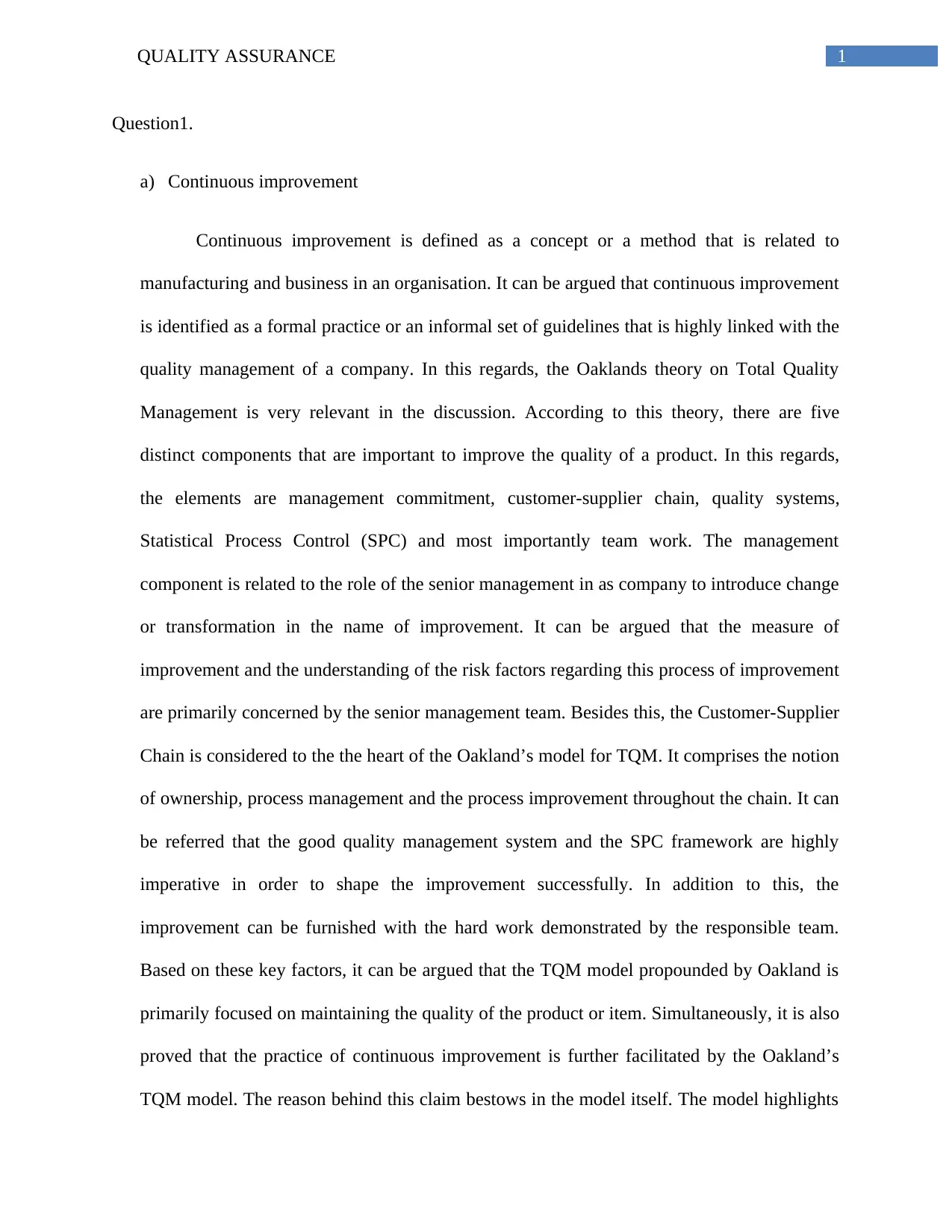
1QUALITY ASSURANCE
Question1.
a) Continuous improvement
Continuous improvement is defined as a concept or a method that is related to
manufacturing and business in an organisation. It can be argued that continuous improvement
is identified as a formal practice or an informal set of guidelines that is highly linked with the
quality management of a company. In this regards, the Oaklands theory on Total Quality
Management is very relevant in the discussion. According to this theory, there are five
distinct components that are important to improve the quality of a product. In this regards,
the elements are management commitment, customer-supplier chain, quality systems,
Statistical Process Control (SPC) and most importantly team work. The management
component is related to the role of the senior management in as company to introduce change
or transformation in the name of improvement. It can be argued that the measure of
improvement and the understanding of the risk factors regarding this process of improvement
are primarily concerned by the senior management team. Besides this, the Customer-Supplier
Chain is considered to the the heart of the Oakland’s model for TQM. It comprises the notion
of ownership, process management and the process improvement throughout the chain. It can
be referred that the good quality management system and the SPC framework are highly
imperative in order to shape the improvement successfully. In addition to this, the
improvement can be furnished with the hard work demonstrated by the responsible team.
Based on these key factors, it can be argued that the TQM model propounded by Oakland is
primarily focused on maintaining the quality of the product or item. Simultaneously, it is also
proved that the practice of continuous improvement is further facilitated by the Oakland’s
TQM model. The reason behind this claim bestows in the model itself. The model highlights
Question1.
a) Continuous improvement
Continuous improvement is defined as a concept or a method that is related to
manufacturing and business in an organisation. It can be argued that continuous improvement
is identified as a formal practice or an informal set of guidelines that is highly linked with the
quality management of a company. In this regards, the Oaklands theory on Total Quality
Management is very relevant in the discussion. According to this theory, there are five
distinct components that are important to improve the quality of a product. In this regards,
the elements are management commitment, customer-supplier chain, quality systems,
Statistical Process Control (SPC) and most importantly team work. The management
component is related to the role of the senior management in as company to introduce change
or transformation in the name of improvement. It can be argued that the measure of
improvement and the understanding of the risk factors regarding this process of improvement
are primarily concerned by the senior management team. Besides this, the Customer-Supplier
Chain is considered to the the heart of the Oakland’s model for TQM. It comprises the notion
of ownership, process management and the process improvement throughout the chain. It can
be referred that the good quality management system and the SPC framework are highly
imperative in order to shape the improvement successfully. In addition to this, the
improvement can be furnished with the hard work demonstrated by the responsible team.
Based on these key factors, it can be argued that the TQM model propounded by Oakland is
primarily focused on maintaining the quality of the product or item. Simultaneously, it is also
proved that the practice of continuous improvement is further facilitated by the Oakland’s
TQM model. The reason behind this claim bestows in the model itself. The model highlights
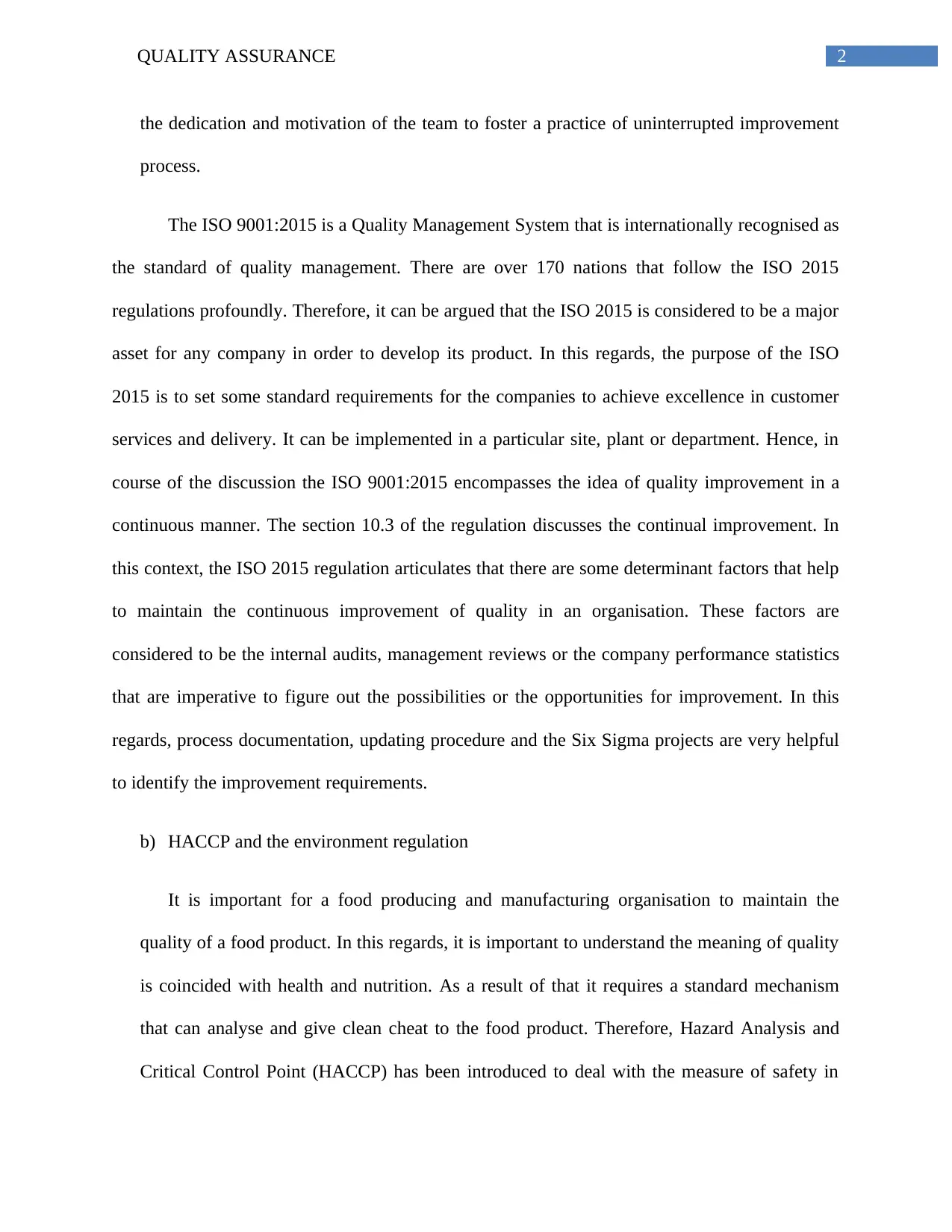
2QUALITY ASSURANCE
the dedication and motivation of the team to foster a practice of uninterrupted improvement
process.
The ISO 9001:2015 is a Quality Management System that is internationally recognised as
the standard of quality management. There are over 170 nations that follow the ISO 2015
regulations profoundly. Therefore, it can be argued that the ISO 2015 is considered to be a major
asset for any company in order to develop its product. In this regards, the purpose of the ISO
2015 is to set some standard requirements for the companies to achieve excellence in customer
services and delivery. It can be implemented in a particular site, plant or department. Hence, in
course of the discussion the ISO 9001:2015 encompasses the idea of quality improvement in a
continuous manner. The section 10.3 of the regulation discusses the continual improvement. In
this context, the ISO 2015 regulation articulates that there are some determinant factors that help
to maintain the continuous improvement of quality in an organisation. These factors are
considered to be the internal audits, management reviews or the company performance statistics
that are imperative to figure out the possibilities or the opportunities for improvement. In this
regards, process documentation, updating procedure and the Six Sigma projects are very helpful
to identify the improvement requirements.
b) HACCP and the environment regulation
It is important for a food producing and manufacturing organisation to maintain the
quality of a food product. In this regards, it is important to understand the meaning of quality
is coincided with health and nutrition. As a result of that it requires a standard mechanism
that can analyse and give clean cheat to the food product. Therefore, Hazard Analysis and
Critical Control Point (HACCP) has been introduced to deal with the measure of safety in
the dedication and motivation of the team to foster a practice of uninterrupted improvement
process.
The ISO 9001:2015 is a Quality Management System that is internationally recognised as
the standard of quality management. There are over 170 nations that follow the ISO 2015
regulations profoundly. Therefore, it can be argued that the ISO 2015 is considered to be a major
asset for any company in order to develop its product. In this regards, the purpose of the ISO
2015 is to set some standard requirements for the companies to achieve excellence in customer
services and delivery. It can be implemented in a particular site, plant or department. Hence, in
course of the discussion the ISO 9001:2015 encompasses the idea of quality improvement in a
continuous manner. The section 10.3 of the regulation discusses the continual improvement. In
this context, the ISO 2015 regulation articulates that there are some determinant factors that help
to maintain the continuous improvement of quality in an organisation. These factors are
considered to be the internal audits, management reviews or the company performance statistics
that are imperative to figure out the possibilities or the opportunities for improvement. In this
regards, process documentation, updating procedure and the Six Sigma projects are very helpful
to identify the improvement requirements.
b) HACCP and the environment regulation
It is important for a food producing and manufacturing organisation to maintain the
quality of a food product. In this regards, it is important to understand the meaning of quality
is coincided with health and nutrition. As a result of that it requires a standard mechanism
that can analyse and give clean cheat to the food product. Therefore, Hazard Analysis and
Critical Control Point (HACCP) has been introduced to deal with the measure of safety in
⊘ This is a preview!⊘
Do you want full access?
Subscribe today to unlock all pages.

Trusted by 1+ million students worldwide
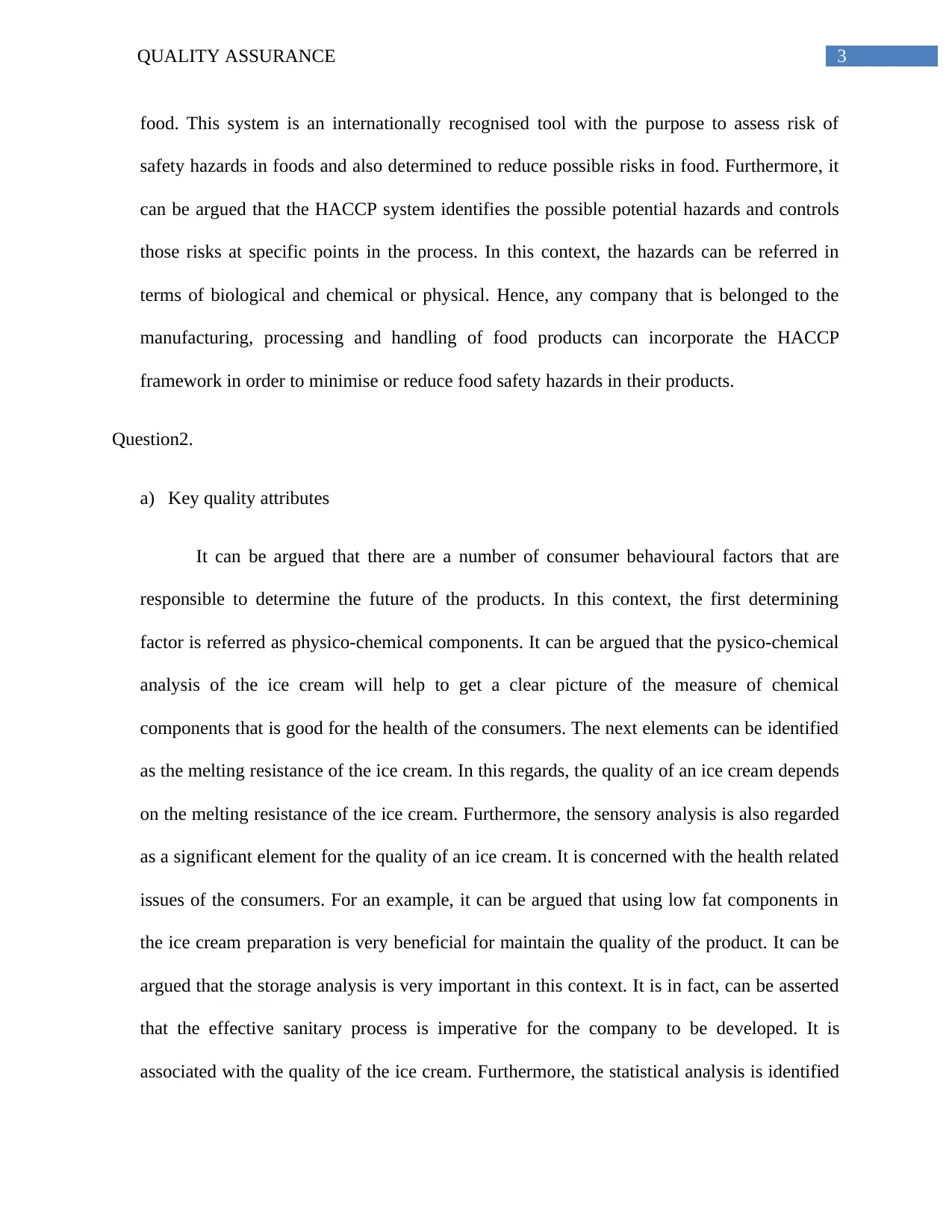
3QUALITY ASSURANCE
food. This system is an internationally recognised tool with the purpose to assess risk of
safety hazards in foods and also determined to reduce possible risks in food. Furthermore, it
can be argued that the HACCP system identifies the possible potential hazards and controls
those risks at specific points in the process. In this context, the hazards can be referred in
terms of biological and chemical or physical. Hence, any company that is belonged to the
manufacturing, processing and handling of food products can incorporate the HACCP
framework in order to minimise or reduce food safety hazards in their products.
Question2.
a) Key quality attributes
It can be argued that there are a number of consumer behavioural factors that are
responsible to determine the future of the products. In this context, the first determining
factor is referred as physico-chemical components. It can be argued that the pysico-chemical
analysis of the ice cream will help to get a clear picture of the measure of chemical
components that is good for the health of the consumers. The next elements can be identified
as the melting resistance of the ice cream. In this regards, the quality of an ice cream depends
on the melting resistance of the ice cream. Furthermore, the sensory analysis is also regarded
as a significant element for the quality of an ice cream. It is concerned with the health related
issues of the consumers. For an example, it can be argued that using low fat components in
the ice cream preparation is very beneficial for maintain the quality of the product. It can be
argued that the storage analysis is very important in this context. It is in fact, can be asserted
that the effective sanitary process is imperative for the company to be developed. It is
associated with the quality of the ice cream. Furthermore, the statistical analysis is identified
food. This system is an internationally recognised tool with the purpose to assess risk of
safety hazards in foods and also determined to reduce possible risks in food. Furthermore, it
can be argued that the HACCP system identifies the possible potential hazards and controls
those risks at specific points in the process. In this context, the hazards can be referred in
terms of biological and chemical or physical. Hence, any company that is belonged to the
manufacturing, processing and handling of food products can incorporate the HACCP
framework in order to minimise or reduce food safety hazards in their products.
Question2.
a) Key quality attributes
It can be argued that there are a number of consumer behavioural factors that are
responsible to determine the future of the products. In this context, the first determining
factor is referred as physico-chemical components. It can be argued that the pysico-chemical
analysis of the ice cream will help to get a clear picture of the measure of chemical
components that is good for the health of the consumers. The next elements can be identified
as the melting resistance of the ice cream. In this regards, the quality of an ice cream depends
on the melting resistance of the ice cream. Furthermore, the sensory analysis is also regarded
as a significant element for the quality of an ice cream. It is concerned with the health related
issues of the consumers. For an example, it can be argued that using low fat components in
the ice cream preparation is very beneficial for maintain the quality of the product. It can be
argued that the storage analysis is very important in this context. It is in fact, can be asserted
that the effective sanitary process is imperative for the company to be developed. It is
associated with the quality of the ice cream. Furthermore, the statistical analysis is identified
Paraphrase This Document
Need a fresh take? Get an instant paraphrase of this document with our AI Paraphraser
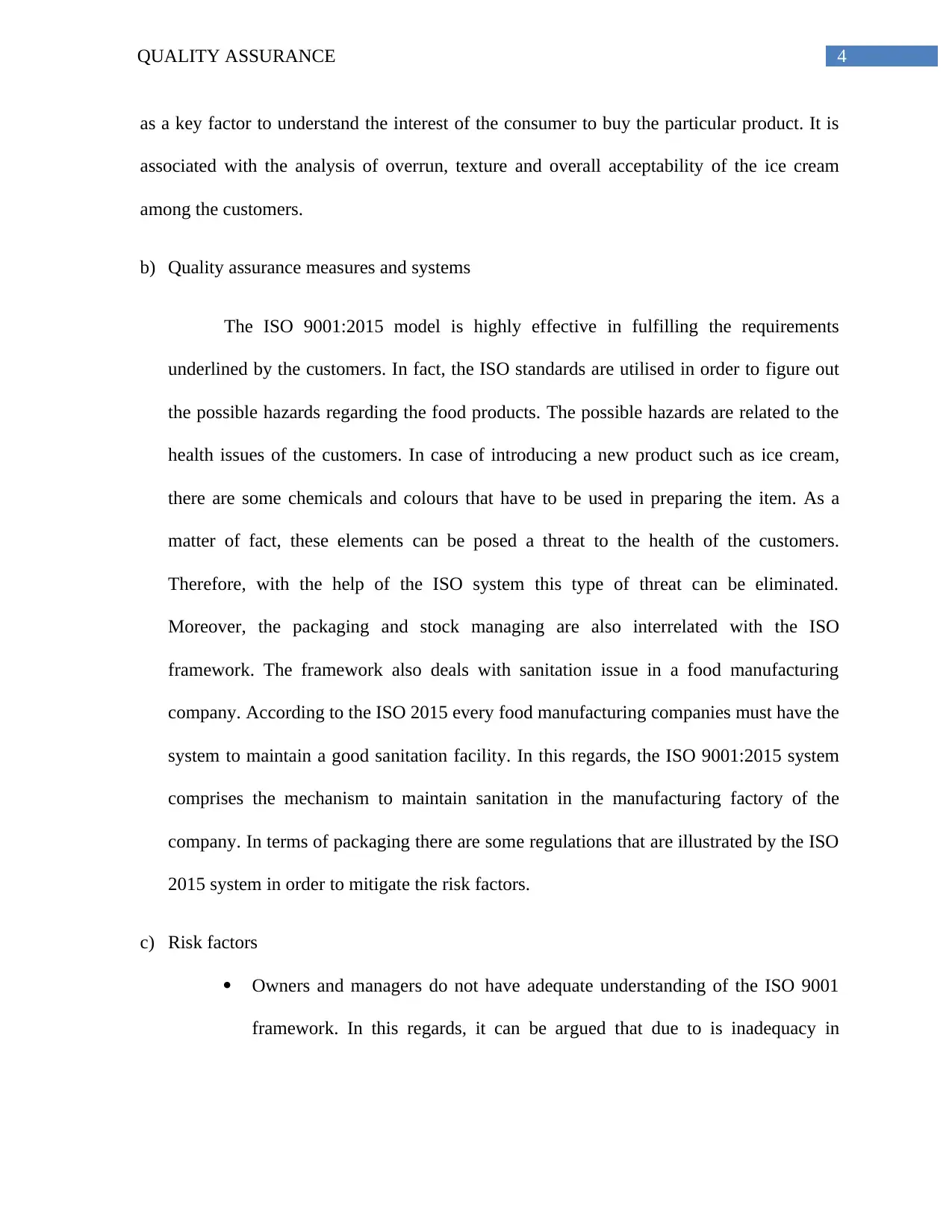
4QUALITY ASSURANCE
as a key factor to understand the interest of the consumer to buy the particular product. It is
associated with the analysis of overrun, texture and overall acceptability of the ice cream
among the customers.
b) Quality assurance measures and systems
The ISO 9001:2015 model is highly effective in fulfilling the requirements
underlined by the customers. In fact, the ISO standards are utilised in order to figure out
the possible hazards regarding the food products. The possible hazards are related to the
health issues of the customers. In case of introducing a new product such as ice cream,
there are some chemicals and colours that have to be used in preparing the item. As a
matter of fact, these elements can be posed a threat to the health of the customers.
Therefore, with the help of the ISO system this type of threat can be eliminated.
Moreover, the packaging and stock managing are also interrelated with the ISO
framework. The framework also deals with sanitation issue in a food manufacturing
company. According to the ISO 2015 every food manufacturing companies must have the
system to maintain a good sanitation facility. In this regards, the ISO 9001:2015 system
comprises the mechanism to maintain sanitation in the manufacturing factory of the
company. In terms of packaging there are some regulations that are illustrated by the ISO
2015 system in order to mitigate the risk factors.
c) Risk factors
Owners and managers do not have adequate understanding of the ISO 9001
framework. In this regards, it can be argued that due to is inadequacy in
as a key factor to understand the interest of the consumer to buy the particular product. It is
associated with the analysis of overrun, texture and overall acceptability of the ice cream
among the customers.
b) Quality assurance measures and systems
The ISO 9001:2015 model is highly effective in fulfilling the requirements
underlined by the customers. In fact, the ISO standards are utilised in order to figure out
the possible hazards regarding the food products. The possible hazards are related to the
health issues of the customers. In case of introducing a new product such as ice cream,
there are some chemicals and colours that have to be used in preparing the item. As a
matter of fact, these elements can be posed a threat to the health of the customers.
Therefore, with the help of the ISO system this type of threat can be eliminated.
Moreover, the packaging and stock managing are also interrelated with the ISO
framework. The framework also deals with sanitation issue in a food manufacturing
company. According to the ISO 2015 every food manufacturing companies must have the
system to maintain a good sanitation facility. In this regards, the ISO 9001:2015 system
comprises the mechanism to maintain sanitation in the manufacturing factory of the
company. In terms of packaging there are some regulations that are illustrated by the ISO
2015 system in order to mitigate the risk factors.
c) Risk factors
Owners and managers do not have adequate understanding of the ISO 9001
framework. In this regards, it can be argued that due to is inadequacy in
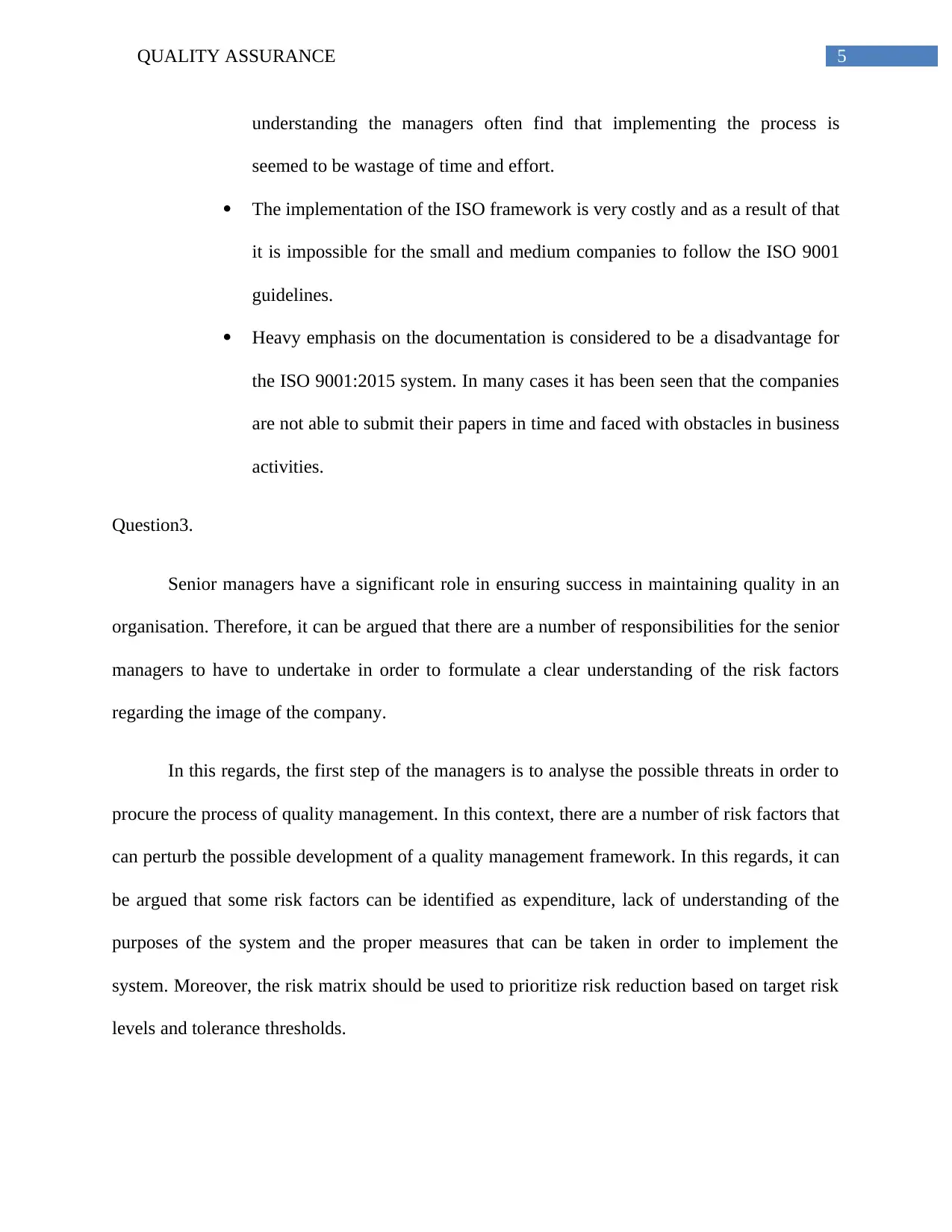
5QUALITY ASSURANCE
understanding the managers often find that implementing the process is
seemed to be wastage of time and effort.
The implementation of the ISO framework is very costly and as a result of that
it is impossible for the small and medium companies to follow the ISO 9001
guidelines.
Heavy emphasis on the documentation is considered to be a disadvantage for
the ISO 9001:2015 system. In many cases it has been seen that the companies
are not able to submit their papers in time and faced with obstacles in business
activities.
Question3.
Senior managers have a significant role in ensuring success in maintaining quality in an
organisation. Therefore, it can be argued that there are a number of responsibilities for the senior
managers to have to undertake in order to formulate a clear understanding of the risk factors
regarding the image of the company.
In this regards, the first step of the managers is to analyse the possible threats in order to
procure the process of quality management. In this context, there are a number of risk factors that
can perturb the possible development of a quality management framework. In this regards, it can
be argued that some risk factors can be identified as expenditure, lack of understanding of the
purposes of the system and the proper measures that can be taken in order to implement the
system. Moreover, the risk matrix should be used to prioritize risk reduction based on target risk
levels and tolerance thresholds.
understanding the managers often find that implementing the process is
seemed to be wastage of time and effort.
The implementation of the ISO framework is very costly and as a result of that
it is impossible for the small and medium companies to follow the ISO 9001
guidelines.
Heavy emphasis on the documentation is considered to be a disadvantage for
the ISO 9001:2015 system. In many cases it has been seen that the companies
are not able to submit their papers in time and faced with obstacles in business
activities.
Question3.
Senior managers have a significant role in ensuring success in maintaining quality in an
organisation. Therefore, it can be argued that there are a number of responsibilities for the senior
managers to have to undertake in order to formulate a clear understanding of the risk factors
regarding the image of the company.
In this regards, the first step of the managers is to analyse the possible threats in order to
procure the process of quality management. In this context, there are a number of risk factors that
can perturb the possible development of a quality management framework. In this regards, it can
be argued that some risk factors can be identified as expenditure, lack of understanding of the
purposes of the system and the proper measures that can be taken in order to implement the
system. Moreover, the risk matrix should be used to prioritize risk reduction based on target risk
levels and tolerance thresholds.
⊘ This is a preview!⊘
Do you want full access?
Subscribe today to unlock all pages.

Trusted by 1+ million students worldwide
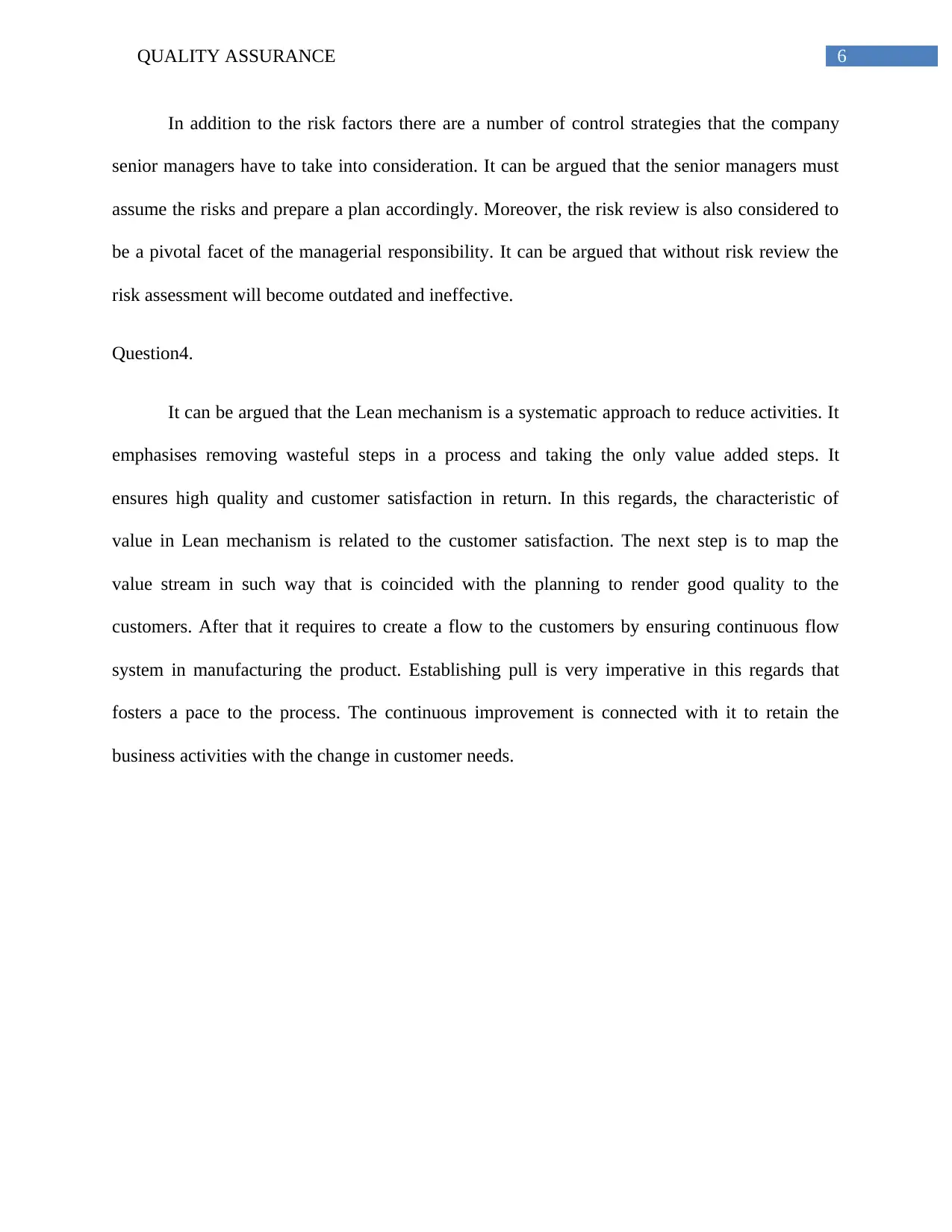
6QUALITY ASSURANCE
In addition to the risk factors there are a number of control strategies that the company
senior managers have to take into consideration. It can be argued that the senior managers must
assume the risks and prepare a plan accordingly. Moreover, the risk review is also considered to
be a pivotal facet of the managerial responsibility. It can be argued that without risk review the
risk assessment will become outdated and ineffective.
Question4.
It can be argued that the Lean mechanism is a systematic approach to reduce activities. It
emphasises removing wasteful steps in a process and taking the only value added steps. It
ensures high quality and customer satisfaction in return. In this regards, the characteristic of
value in Lean mechanism is related to the customer satisfaction. The next step is to map the
value stream in such way that is coincided with the planning to render good quality to the
customers. After that it requires to create a flow to the customers by ensuring continuous flow
system in manufacturing the product. Establishing pull is very imperative in this regards that
fosters a pace to the process. The continuous improvement is connected with it to retain the
business activities with the change in customer needs.
In addition to the risk factors there are a number of control strategies that the company
senior managers have to take into consideration. It can be argued that the senior managers must
assume the risks and prepare a plan accordingly. Moreover, the risk review is also considered to
be a pivotal facet of the managerial responsibility. It can be argued that without risk review the
risk assessment will become outdated and ineffective.
Question4.
It can be argued that the Lean mechanism is a systematic approach to reduce activities. It
emphasises removing wasteful steps in a process and taking the only value added steps. It
ensures high quality and customer satisfaction in return. In this regards, the characteristic of
value in Lean mechanism is related to the customer satisfaction. The next step is to map the
value stream in such way that is coincided with the planning to render good quality to the
customers. After that it requires to create a flow to the customers by ensuring continuous flow
system in manufacturing the product. Establishing pull is very imperative in this regards that
fosters a pace to the process. The continuous improvement is connected with it to retain the
business activities with the change in customer needs.
Paraphrase This Document
Need a fresh take? Get an instant paraphrase of this document with our AI Paraphraser
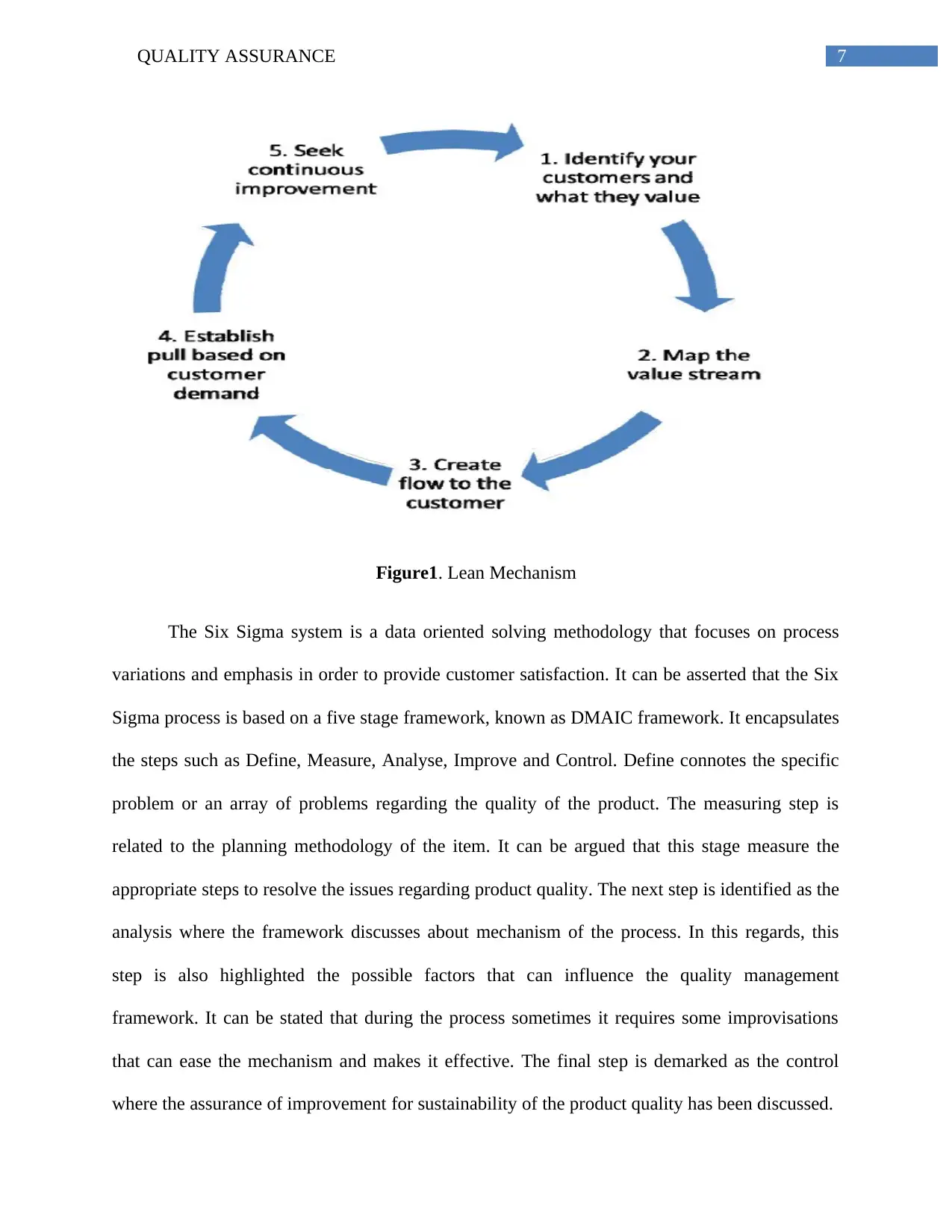
7QUALITY ASSURANCE
Figure1. Lean Mechanism
The Six Sigma system is a data oriented solving methodology that focuses on process
variations and emphasis in order to provide customer satisfaction. It can be asserted that the Six
Sigma process is based on a five stage framework, known as DMAIC framework. It encapsulates
the steps such as Define, Measure, Analyse, Improve and Control. Define connotes the specific
problem or an array of problems regarding the quality of the product. The measuring step is
related to the planning methodology of the item. It can be argued that this stage measure the
appropriate steps to resolve the issues regarding product quality. The next step is identified as the
analysis where the framework discusses about mechanism of the process. In this regards, this
step is also highlighted the possible factors that can influence the quality management
framework. It can be stated that during the process sometimes it requires some improvisations
that can ease the mechanism and makes it effective. The final step is demarked as the control
where the assurance of improvement for sustainability of the product quality has been discussed.
Figure1. Lean Mechanism
The Six Sigma system is a data oriented solving methodology that focuses on process
variations and emphasis in order to provide customer satisfaction. It can be asserted that the Six
Sigma process is based on a five stage framework, known as DMAIC framework. It encapsulates
the steps such as Define, Measure, Analyse, Improve and Control. Define connotes the specific
problem or an array of problems regarding the quality of the product. The measuring step is
related to the planning methodology of the item. It can be argued that this stage measure the
appropriate steps to resolve the issues regarding product quality. The next step is identified as the
analysis where the framework discusses about mechanism of the process. In this regards, this
step is also highlighted the possible factors that can influence the quality management
framework. It can be stated that during the process sometimes it requires some improvisations
that can ease the mechanism and makes it effective. The final step is demarked as the control
where the assurance of improvement for sustainability of the product quality has been discussed.
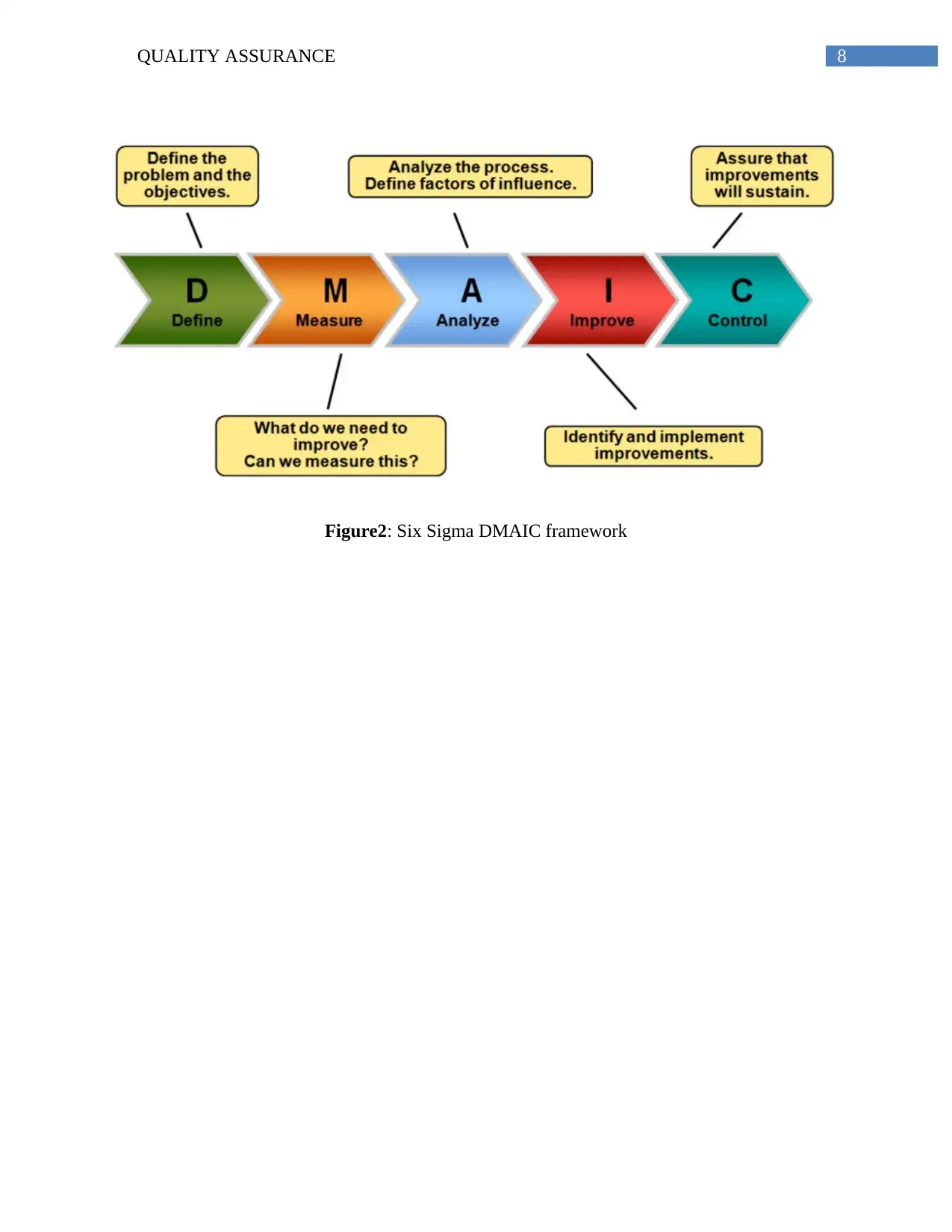
8QUALITY ASSURANCE
Figure2: Six Sigma DMAIC framework
Figure2: Six Sigma DMAIC framework
⊘ This is a preview!⊘
Do you want full access?
Subscribe today to unlock all pages.

Trusted by 1+ million students worldwide
1 out of 9
Related Documents
Your All-in-One AI-Powered Toolkit for Academic Success.
+13062052269
info@desklib.com
Available 24*7 on WhatsApp / Email
![[object Object]](/_next/static/media/star-bottom.7253800d.svg)
Unlock your academic potential
Copyright © 2020–2025 A2Z Services. All Rights Reserved. Developed and managed by ZUCOL.





